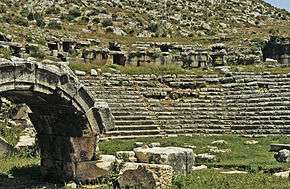Limyra
| Λιμύρα | |
 Limyra Theater | |
 Shown within Turkey | |
| Location | Antalya Province, Turkey |
|---|---|
| Region | Lycia |
| Coordinates | 36°20′38″N 30°10′17″E / 36.343873°N 30.171289°E |
| Type | Settlement |
| History | |
| Cultures | Hellenic/Persian |
| Site notes | |
| Condition | In ruins |
Limyra (in Greek Λιμύρα) was a small city in Lycia on the southern coast of Asia Minor, on the Limyrus River, and twenty stadia from the mouth of that river.It was a prosperous city, and one of the oldest cities in lycia. The city had rich and abundant soil, and gradually became one of the finest trade settlements in Greece. Pericles adopted it as the capital of the lycian league. The city came under control of the Persian Empire after it was conquered by Cyrus the Great. He later annexed Lydia and its territories after a decisive victory at the Battle of Thymbra and the Siege of Sardis, where he defeated armies twice as large as his. Cyrus then got his greatest general: Harpagus of Media to conquer the much smaller kingdoms in Anatolia, while he went to conquer the Neo-Babylonian Empire. Anatolia would become an important place for the Persian monarchs who succeeded Cyrus. The massive Royal road constructed by Darius went from the Persian capital of Persepolis, to the Anatolian city of Sardis. Limyra would stay under Persian control until the very end of its days, when it was conquered and sacked by Alexander the Great.
It is mentioned by Strabo (XIV, 666), Ptolemy (V, 3, 6) and several Latin authors. Gaius Caesar, adopted son of Augustus, died there (Velleius Paterculus, II, 102).
The ruins of Limyra are about 5 km northeast of the town of Finike (ancient Phoenicus) in Antalya Province, Turkey. They consist of a theatre, tombs, sarcophagi, bas-reliefs, Greek and Lycian inscriptions etc. About 3 km east of the site is the Roman Bridge at Limyra, one of the oldest segmental arch bridges of the world.[1] mes,
Ecclesiastical history
Limyra is mentioned as a bishopric in Notitiæ Episcopatuum down to the 12th and 13th centuries as a suffragan of the metropolitan of Myra.
Six bishops are known: Diotimus, mentioned by St. Basil (ep. ccxviii); Lupicinus, present at the First Council of Constantinople, 381; Stephen, at the Council of Chalcedon (451); Theodore, at the Second Council of Constantinople in 553; Leo, at the Second Council of Nicaea in 787; Nicephorus, at the so-called Photian Council of Constantinople (879).[1]
In the Annuario Pontificio it is listed as a titular see of the Roman province of Lycia.[2]
References
- 1 2 Sopheone Pétridès, "Limyra" in Catholic Encyclopedia (New York 1910)
- ↑ Annuario Pontificio 2013 (Libreria Editrice Vaticana 2013 ISBN 978-88-209-9070-1), p. 917
| Wikimedia Commons has media related to Limyra. |
Coordinates: 36°20′34.19″N 30°10′13.87″E / 36.3428306°N 30.1705194°E